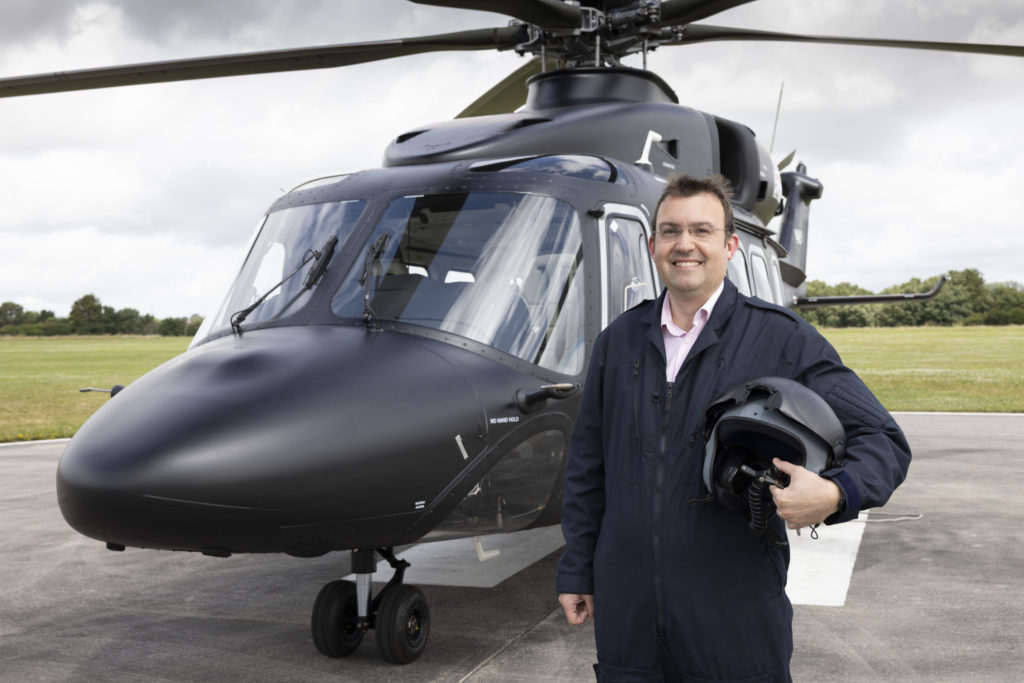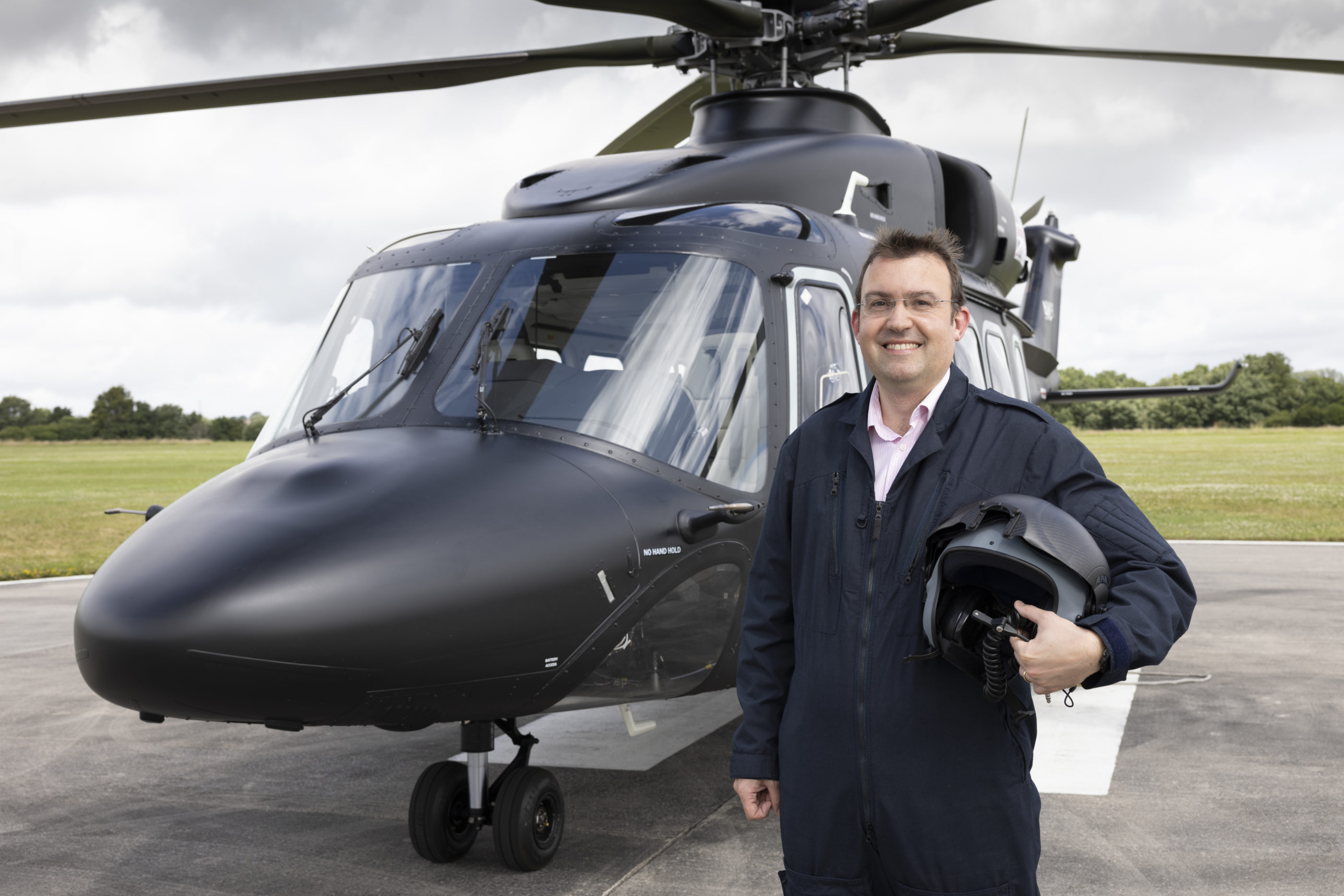With large-scale redevelopment at Leonardo’s Yeovil production facility, investment in an unmanned aircraft demonstrator for the U.K.’s Royal Navy, and pitching the AW149 as a contender for the RAF’s New Medium Helicopter (NMH) requirement, Adam Clarke certainly has his work cut out.
Clarke was recently appointed the new managing director of Leonardo’s U.K. helicopter division, having previously served as director of strategy and competitor analysis of its electronics division. His 20-year career with the company means he’s ideally placed to take the helicopter branch of the company forward in what is proving to be an interesting time for Leonardo in the U.K.
During a recent media briefing, Clarke said the Leonardo group is investing £1 billion (US$1.2B) across its U.K. industry and facilities as part of a drive to “grow the corporation within the U.K.”
He made it clear NMH is one of the leading programs within the company, and said Leonardo sees itself in an ideal position with the AW149. It is investing in its Yeovil facility to prepare it for production of the type, and several employees have been sent to Italy to learn manufacturing and assembly work related to its production.
Moving to autonomous development, Clarke called Leonardo’s RWUAS (Rotary-Winged Unmanned Air System) “an exciting project” that is focused on the future of unmanned capabilities. The current program, he said, will lead to a demonstrator.
“It’s about proving the capabilities of an uncrewed platform, with the Royal Navy as the lead in this,” said Clarke. “The RWUAS contract is about taking a series of systems forward that will hopefully excite people in wanting to come and work with us on it and use emerging cutting-edge technologies.”
Leonardo is currently in the concept stage with RWUAS, and although a few design ideas have been released, they may not resemble the final platform. Clarke described the program as being “an agile contract, that does not have a fixed set of requirements.” However, there are some key parameters that must be met.
He said Leonardo will be happy to team up with external partners on the program.
“We’re [Leonardo] willing to act more positively with companies, and use their innovations rather than do everything ourselves,” said Clarke. He added that he was keen to employ this kind of partnership approach more widely.
“I am aware that we can’t, as a company, do everything — and to grow, we will need to work with other businesses. It’s an approach I have used throughout my career,” he said. “In some ways, it will be a culture change that won’t happen overnight. It may well take the form of starting with a simple partnership which may lead to a larger joint venture.”
Clarke noted that Leonardo recently signed the Rotary Winged Enterprise (RWE) agreement for the U.K. Ministry of Defence, DE&S, industry, and frontline commands. This will see it working with Boeing on how to provide better support for the Chinook, Wildcat, Merlin, and Apache.

“It’s about how rotary support is done today and how it should be done in the future,” said Clarke. “It’s a top to bottom review with everything from processes and practices that staff complete.” This will extend into the logistics of base support to the processes of providing upgrades to platforms that are already in operational service.
Clarke said the signing is likely to lead to improvements not only in the U.K.’s industry, but in the Ministry of Defence and frontline command as well. It’s a positive agreement that looks set to transform how things are performed.
Wildcat Support
Continuing the focus on frontline U.K. types, Leonardo has recently signed an extension to its Wildcat support programme, which Clarke described as “extremely important to Leonardo.”
The program goes beyond the more familiar maintenance and repair setup. “We’ll be looking at safety management aspects, ways of improving synthetic ground-based training, and maintenance and overhaul processes,” said Clarke. “There tends to be a lot of paperwork generated for anything associated with these aspects, so we’re looking at ways to remove or certainly improve current methods.”
Looking towards the next generation of future platforms, such as those within Europe, and the American Future Attack Reconnaissance Aircraft (FARA) and Future Long-Range Assault Aircraft (FLRAA), Clarke said there is a desire to become involved with some of these programs, but those within Europe may be a problem with the U.K. no longer a part of the European Union (E.U.). This includes programs funded by the E.U., such as the European Defence Fund projects, as the U.K. can no longer be a part of it.
“But NATO projects are different, and we can be involved in these,” said Clarke. “We have colleagues working in Italy at present, although I can’t say any more at the moment.”
In terms of the current programs at Yeovil, Clarke said active campaigns for the Wildcat and Merlin are ongoing, and announcements for both will be made before the year-end. However, he didn’t reveal which new countries have ordered the types.
In terms of the future competitive programs, Clarke said Leonardo’s Yeovil site has a unique selling point. “We have design [and] development, which have ‘spin-off’ activities as well as production,” he said. “We have the manufacturing capability of certain parts, along with assembly, integration and test facilities. There are flight operations along with aviation safety certification, so we have the end-to-end capability at Yeovil, which is quite a powerful statement.”He added that winning a competitive tender matters. “It shows that we have a competitive product that has been selected independently,” he said. “I want that user to select our product because it’s a great product.”









